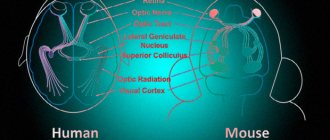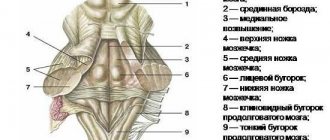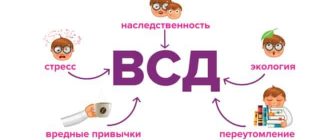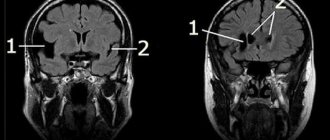Stages of disease progression
Mild, moderate and severe degrees of idiocy are essentially not much different from each other
With mild to moderate mental retardation, the patient can be taught the simplest things. They have more developed sensitivity.
They can distinguish cold from hot, high from low. Patients are able to provide basic care for themselves. They recognize their relatives or guardians, showing joy when they appear. They can construct simple sentences from a couple of words and respond to their name.
Severe degree is the patient’s complete exclusion from life. Oligophrenics with deep idiocy have difficulty moving, or do not know how to walk at all, their movements are erratic and uncoordinated. They don't recognize their relatives.
The sensitivity threshold is very low: they do not respond to pain, as well as to other irritants. They do not know how to get out of bed on their own, falling to the floor during such attempts. Patients do not speak, occasionally making only inarticulate sounds.
This degree is characterized by profound disability. As an individual, a person is not present in society. Serious idiots spend their lives in psychoneurological boarding schools. Lifespan is about 40 years.
Diagnosis and tests
Most often, debility manifests itself at school, when the child ceases to be aware and understand what is happening. This is why there are medical examinations and psychological tests, which are conducted from time to time by a school psychologist to identify special children. To determine debility, there are many psychometric tasks and tests to determine the level of intellectual development.
Eysenck test
Hans Eysenck is an English psychologist who created a test to determine the level of intellectual development. It allows you to identify many diseases and reveal hidden mental abilities. There are 8 versions of Eysenck tests, and they are designed for the age category from 18 to 60 years.
There are tasks that are based on the Eysenck test and are designed for children. They allow you to define analytical, synthetic and logical thinking. The results are calculated so that the average value is 100. This is approximately the level for most people. A value less than 70 is considered a form of mental retardation. An accurate diagnosis is made after a more detailed analysis and examination of the patient.
Wojnarowski test
This is a psychological test of logic, and it does not require special knowledge or skills. The tests consist of a condition and 3 consequences, among which you need to choose 1 correct solution. Often the condition contains unfamiliar or non-existent words. But this is not the point, but to understand the condition and choose the right consequence.
The test has only 30 questions that can be answered within 15 minutes. For a person who does not have developmental problems, they are not difficult. Based on the results, you can understand whether a person has logic.
Speech Development Assessment
Assessment of speech development is carried out in children of preschool and school age. Children with speech impairment often lag behind in the educational process, so the problem needs to be identified and addressed in a timely manner. This is usually done by a speech therapist in secondary schools and kindergartens.
With mental development, speech develops late. A child must speak before the age of 3. If this does not happen, this is a cause for concern. Previously, children began to speak earlier, but modern society largely depends on gadgets, so experts say that later speech development is already considered the norm.
Babbling and cooing in children should begin at 3-6 months. In children with debility, it appears after about a year. Scientists described the problems and features of late speech development in children. Correction is carried out depending on the degree of mental retardation. It should be comprehensive in nature with drug treatment and psychological and pedagogical studies.
Torrens test
This is a method of psychodiagnostics of human creativity and creative abilities. The Eysenck test is not the only one that determines a person’s capabilities. The Torrance test allows you to recognize the level of thinking, fantasy and logic at the same time. High results provide an opportunity to see the child’s creative potential. Too low a result indicates mental development.
Creative abilities directly depend on the ability to learn to understand what is happening and analyze the situation. Children with mental retardation do not possess such skills and, as a result of testing, cannot show high results.
Moronic imbecility idiocy
Patients suffering from oligophrenia may differ in level of development depending on the type. Mental retardation is divided into debility, imbecility and idiocy. Debility on this list is the least complex case of pathology. Patients are able to care for themselves. Many graduate from a specialized school and in the future can lead an almost full-fledged lifestyle, working in production, performing simple ore operations, for example, cleaning, loading and unloading. Due to impaired perception of the surrounding world, persons suffering from oligophrenia in the stage of debility require lifelong monitoring.
Symptoms and signs of idiocy
Idiocy is the most severe form of mental retardation. Degrees of idiocy manifest themselves in the form of congenital or very early-onset manifestations. With age, all symptoms only get worse.
Idiocy cannot be reversed, intelligence is almost impossible to improve, and with age there is only progression of deterioration. As a rule, idiocy is noticeable from the first days of a baby’s life; they are so retarded in development that even at diaper age, doctors notice the problem, especially since the medical history of such individuals is always burdened. Physically, there is usually such a pronounced pathology that it is very difficult to provide help. The body is quite damaged, often such children are not able to move and remain completely recumbent. Psychomotor development is deeply inhibited from birth; much later they begin to make all the physiological changes, raise their heads, sit down. And sometimes, for example, with Rett syndrome, development proceeds normally up to two years, and then regression occurs with a significant developmental delay. Such a person never learns to speak, her emotions are not differentiated, she continues to exist on unconditional instincts all her life. The problem is that they do not even distinguish between what is edible and are capable of eating even their own excrement, just like other people’s, if they have access to it. Thought processes are absolutely not typical for them, intelligence is completely absent, it is not even possible to teach them basic skills. They are not able to recognize loved ones and do not express reactions at all, in particular emotional ones; in essence, these are, alas, plants, but they are not beneficial.
Diagnosis of idiocy is quite simple, if we talk about the diagnosis itself, but it is not always possible to identify the reasons due to the high cost of genetic research
But it is very important to give parents the chance to have genetically healthy offspring. In genetic matters, the genome of the entire genus plays a great role.
These people are very different from normal children; even when they acquire the skill of walking, friendly hand movements are not performed, which often leads to traumatization of such an individual. Often there is a violation not only in the morphological structure, but also in the physiology of the internal organs, there are heart defects, various stigmas of dysembryogenesis, and hydrocephalus. They can be very euphoric, even to the point of mania, or aggressive, but more often there is practically no emotion revealed. They can moo, scream, sniffle, and emit various sound vibrations. The sensitivity threshold of all types is increased, which leads to a decrease in feelings. This is especially dangerous for various diseases, since they will not complain of pain during a banal acute surgery, such as appendicitis, you need to look at objective data, which is often not available. They may harm themselves by grabbing something hot or sharp.
Classification
Idiocy is classified according to severity:
- Mild and moderate degrees are characterized by the ability of patients to develop a simple outlook. For example, understanding that you should not touch the flame or put your hand in boiling water. Children master the simplest self-care skills, have an attachment to caregivers, remember simple words, but pronounce them incorrectly, change or omit syllables in words, have a lisp, and a nasal voice.
- Severe degree. There is an almost complete absence of speech and self-care skills. The patient's life is regulated by instincts. After birth, babies immediately end up in boarding schools for psychochronic patients.
By time and reasons of occurrence:
- Amaurotic idiocy is based on a violation of the metabolism of gangliosides (complex molecules) in the brain. Intelligence is declining steadily.
- Congenital - characterized by progressive hydrocephalus (excess water in the brain tissue), muscle hypotonia (decreased muscle tone), convulsions, and mental underdevelopment.
- Early childhood - develops in the first years of life, is characterized by progressive paralysis, decreased vision, hyperacusis (intolerance to ordinary sounds due to a violation of the balance mechanisms between inhibition and enhancement of biological processes in the auditory pathways), mental underdevelopment.
- Late childhood - characteristic signs appear at 4 years of age: optic nerve atrophy (death of nerve fibers), progressive dementia, convulsions, ataxia (impaired coordination).
- Juvenile - signs appear by age 6. Characterized by decreased mental abilities, movement disorders, memory impairment, vegetative-endocrine disorders, retinitis pigmentosa (degenerative eye disease leading to blindness).
- Late—signs appear in adults. Characterized by personality changes, deafness, vestibulo-cerebellar syndrome (dizziness, loss of balance), retinitis pigmentosa, psychosyndrome (psychological dysfunction).
- Hydrocephalus is a congenital form characterized by dropsy of the brain.
- Xeroderma is a hereditary disease manifested by varying degrees of dementia, hypoplasia (underdevelopment) of the genital organs, xeroderma pigmentosa (high sensitivity to ultraviolet radiation), neurological disorders, and short stature.
- Dysostotic - damage to the connective tissue, as a result of which the organs of vision, bones, nervous system, and internal organs suffer.
- Myxedematous - develops when the thyroid gland malfunctions.
- Thymic - develops when the thymus gland (thymus gland) malfunctions.
According to clinical manifestations
- Excitable - characterized by repetitive movements of the patient (swinging, clapping, primitive movements).
- Torpid - characterized by immobility, “withdrawal” into oneself.
Stages of mental retardation according to IQ (international and Russian classification):
- Minor - IQ 50–70 (moronic).
- Moderate - IQ 35–49 (imbecility).
- Severe - IQ 25–39 (mental retardation in the stage of idiocy).
- Profound - IQ below 20 (profound mental retardation).
Stages of mental retardation.
If we talk about social idiocy, there are 5 forms:
- Loyalty. The main people for this category of patients are their superiors, their opinions and instructions.
- Nihilism. Removal from social and even family processes - from everything that does not concern the patient himself.
- Liberalism. Liberals prioritize complete personal freedom, which in a liberal state results in condoning crimes committed by representatives of sexual minorities, refugees, and the popularization of same-sex love and marriage.
- Jewish admiration. Admiration and exaltation of Jews and the Jewish nation, manifested in the fact that Christ was a Jew, and this people suffered more than others, that there are more brilliant scientists, writers, and so on among Jews than among other nationalities.
- Cleanliness. Expressed in arrogant behavior. Purists consider certain matters and conversations “dirty” and refuse to participate in events and conversations so as not to stoop to the level of their interlocutors and not to “get dirty” themselves.
There is another type of social idiocy - kaleidoscopic. Everything testifies to mental deviations: worldview, reasoning, actions, behavior.
Diagnostics
The diagnosis is made based on IQ indicators, examination of the patient, and conversations with his relatives. The doctor collects family history, evaluates data from genetic screening, diagnostic studies indicating the condition of internal organs. Finds out everything about the mother’s pregnancy and delivery, infections suffered during gestation, and the time of the first appearance of characteristic signs.
The psychiatrist talks with the patient (if possible), assesses mental abilities using special questionnaires, the level of adaptation in society, and attitude towards relatives.
Among the examinations, an MRI of the brain is prescribed, which allows one to judge the structure of the organ and possible deviations. If necessary, patients are consulted by a neurologist, ophthalmologist and other specialized specialists. Parents and the sick child undergo consultation and examination with a geneticist, which makes it possible to find out the cause of cognitive dissonance and identify possible risks in future children.
During the study, patients noted an enlarged brain, diffuse (scattered) atrophy of individual areas (the cerebellum and occipital lobes are most often affected).
Histological examination reveals widespread destruction of neurons (nerve cell, ganglion, ganglion). Degeneration of ganglion cells occurs in the form of an increase in size, swelling, swelling, filling with a fine-grained substance, wrinkling and loss of shape of the nuclei, and a shift of the nuclei to the periphery.
In severe cases, with a high concentration of lipids, demyelination develops (destruction of the myelin sheath surrounding nerve fibers), damage to nerve processes (axons).
Kinds
- Amaurotic idiocy. A genetic disease that is caused by a disorder of glycoside metabolism. In patients it manifests itself in the form of mental retardation and decreased vision;
- Late amaurotic childhood idiocy. Hereditary lipid disease of the brain. Occurs in preschool children;
- Congenital amaurotic idiocy. The first symptoms are observed in newborns;
- Early amaurotic childhood idiocy. This disease manifests itself in children in the first year of life;
- Amaurotic late idiocy (Kufs disease). It manifests itself in adults and occurs as an organic brain lesion;
- Hydrocephalic idiocy. Appears in newborns. This disease is caused by massive hemorrhage into the structures of the brain, with impaired cerebrospinal fluid dynamics, increased intracranial pressure;
- Dysostotic idiocy. A disease that is caused by a hereditary disorder of the connective tissue structure;
- Xerodermic idiocy. This is a hereditary disease; a person has severe dementia, short stature, underdevelopment of the reproductive and nervous systems;
- Myxedema idiocy. Symptoms are caused by congenital hypofunction of the thyroid gland;
- Thymic idiocy. Develops with dysfunction of the thymus gland;
- Moral idiocy. This is a historical term and is not a disease. Used to characterize a person who has lost moral and moral values. Idiots have impaired intellect and emotional-volitional sphere.
Therapy
Full recovery is impossible. Treatment is symptomatic and pathogenetic in nature.
In case of metabolic disorders or endocrine disorders that cause mental retardation, replacement therapy for the missing enzymes or hormones is prescribed.
Symptomatic treatment is aimed at mitigating the manifestations of pathology. Patients are administered restoratives. For overly excitable children, sedatives, antipsychotics, and tranquilizers are used. If the patient is severely lethargic, they are treated with psychostimulants.
For hydrocephalus of the brain, dehydration therapy is indicated. Almost all patients require medications that promote partial restoration of mental functions and physical therapy. Anticonvulsants may be prescribed if you are prone to seizures.
Signs of idiocy
Idiocy is very easy to identify, since it has clear signs of manifestation:
- Dullness is when a person views the world very narrowly and perceives a limited amount of information. Stupidity, insensitivity, lack of intelligence.
- Low self-awareness.
- Inability to analyze information, remember it, and draw your own conclusions.
- Spiritual development practically does not occur.
- Inability to independently swallow food, take it into the mouth, or chew it.
- No defensive movements, only crying or screaming.
- Inability to walk or weak, abnormal gait. In this case, the muscles are not paralyzed.
- Involuntary urination and defecation.
- Speech is practically not developed. Someone does not speak at all, someone can pronounce sounds or syllables, speech is incoherent and meaningless.
- Inactivity, unresponsiveness to new information, silence or, conversely, mobility, talkativeness (mumbling), constantly shoving something in the mouth, attraction to certain people.
- Their level of development can be compared with the intellectual development of a child aged 1 to 4 years.
- Imitation: If you ask a question, they will repeat it.
- Stereotyping in actions.
- Impulsive satisfaction of sexual needs.
- Moral perversion.
- Tendency to lie and deceit.
- They are mostly harmless and safe, but in a state of irritation they can commit actions without assessing their consequences.
With a mild degree of idiocy, patients have a tendency to learn speech, writing and reading. They even acquire basic skills and can learn to do routine, monotonous work. But that's where their level of achievement ends.
Individual idiots have different tendencies to acquire skills in a particular area.
Also, signs of idiocy affect the physiological side:
- Extensive paralysis.
- Epileptic seizures.
- Paralysis of one side of the body.
- Irregular face shapes: asymmetry, enlargement or reduction, ugliness, curvature, incorrect placement of teeth, squint, blindness, ugly ears.
- Pathologies of the genital organs.
- Crooked legs, etc.
There are three forms of oligophrenia - mental retardation:
- Moronism (moronicity).
- Imbecility.
- Idiocy (idiocy) is the most severe form of congenital mental dementia.
Key tasks of a teacher with various mental disabilities
With debility, the main task is to develop simple work skills, as a result of which such patients are subsequently able to engage in unskilled paid labor.
With the development of imbecility, the main task is to develop self-care skills in the patient.
With idiocy, the only question is maintaining the vital functions of the body. Unfortunately, with such a severe form of debility, patients resemble plants that cannot lead life in society.
Causes of oligophrenia
Reasons that provoke the disease:
- endogenous factors (impaired intrauterine development of the fetus);
- exogenous (external - injuries, tumors, etc.);
- a set of reasons.
Endogenous factors include hereditary diseases, genetic and chromosomal mutations, exposure to chemicals on the embryo - drugs, alcohol, radiation, severe maternal stress, infectious and viral diseases of the pregnant woman.
Intellectual deficiency can also be caused by complications during pregnancy - disruption of placental blood flow, Rh conflict, hormonal disorders of the mother (diseases of the thyroid gland, adrenal glands, etc.). External causes that can provoke oligophrenia include birth trauma, asphyxia and hypoxia of the fetus, serious infectious diseases - encephalitis, meningitis. Mental retardation is also caused by severe brain injuries and tumors.
It is important to remember that the clinical picture of oligophrenia depends not only on the causes, but mainly on the development of the child during the period of exposure to factors. For example, if a pregnant woman falls ill with a serious infectious disease in the first trimester, the risk of fetal development disorders is several times higher
At the same time, if the flu or acute respiratory viral infection overtook her in the third trimester, this has practically no effect on the child’s intellectual development. We get the same picture when treating a pregnant woman with drugs - most often in the first 12 weeks the drugs are dangerous for the embryo.
Currently, scientists have identified about 300 diseases that have oligophrenia in their clinical picture. In 80% of cases they are inherited. It has also been proven that when the X chromosome is mutated, the disease occurs in a more severe form. Among these diseases, approximately 80 are metabolic diseases.
Clinical picture of the disease
To diagnose oligophrenia, scientists take into account obvious disorders in three areas:
Human psyche (memory, attention, imagination, perception, etc.); Personal characteristics (self-perception, self-esteem, self-awareness); Somatic – the structure and constitution of the body. For example, children with Down syndrome have similar external characteristics (slanted eyes, typical facial expression).. In industrialized countries, rates of oligophrenia are 1% of the total mass
The ratio of sick men to women is 2:1. It is difficult to identify more accurate statistics, because the data is influenced by many factors - the method of collecting information, the attitude of society towards people with intellectual disabilities, the quality of medical care
In industrialized countries, rates of oligophrenia are 1% of the total mass. The ratio of sick men to women is 2:1. It is difficult to identify more accurate statistics, because the data is influenced by many factors - the method of collecting information, the attitude of society towards people with intellectual disabilities, the quality of medical care.
Complex of provoking factors
The development of idiocy is influenced by 2 factors: external (exogenous) and internal (endogenous), their combination is possible:
- Endogenous : hereditary metabolic disorders, gene mutations, chromosome abnormalities. Idiocy can cause Down syndrome, phenylketonuria, gargoilism, microcephaly. These pathologies are inherited in a recessive manner.
- Exogenous : infectious and toxic damaging influence factors. The first include diseases such as rubella, syphilis, and toxoplasmosis. In the second group: maternal alcoholism, Rh factor incompatibility, uncontrolled use of certain medications during pregnancy.
Birth injuries, asphyxia of the newborn, and intracranial hematomas can aggravate the situation. Although they are not independent causes of dementia.
Symptoms
Symptoms of idiocy:
- The patient has no or sharply reduced reaction to any external stimuli.
- The child does not react to the mother, does not distinguish her from another person.
- Emotional expressions are extremely limited. They come down only to feelings of satisfaction and dissatisfaction.
- Instincts prevail over reason.
- Inability to control urination and bowel movements.
- Gluttony and attempts to feed on inedible objects.
- Constant and open masturbation.
- Severe impairment of motor coordination. Patients are extremely rarely able to walk independently.
- Not developed motor skills.
- Behavior is never motivated by external factors. There is a tendency to impulsive actions.
- Facial expressions are either completely absent or express causeless aggression.
- Sensitivity to pain is greatly reduced. Inability to distinguish hot from cold, sweet from salty, soft from hard.
- Patients do not understand speech addressed to them. They are guided by the intonation and facial expressions of the person speaking. They cannot make contact on their own.
- They are not oriented in space and time.
A profound degree of mental retardation is often accompanied by anomalies of somatic development: heart defects, finger fusions, underdeveloped limbs, cerebral or spinal hernias, as well as blindness, deafness, decreased sensitivity of taste and olfactory receptors. By the end of life, the development of relatively intact patients is close to the level of a 2-3 year old child
general information
Oligophrenia is a metabolic disease of a hereditary nature. Its essence is quite difficult to understand for a person far from medicine. In short, the patient’s body lacks the enzyme involved in the process of phenylalanine metabolism, and the result of this is that phenylalanine along with metabolites begins to accumulate in the child’s body.
This negatively affects the functioning of the central nervous system, causing a toxic effect. Well, this, in turn, inhibits mental development, which gradually results in mental deviations. It is impossible to say when this disease first appeared; it is only known that A. Felling first undertook to describe it in 1934. This disease is sometimes called dementia.
Prevention
Prevention of the disease mostly concerns maintaining a healthy lifestyle during pregnancy. It is necessary to completely give up smoking and alcohol, do not forget to visit a gynecologist, register, take walks in the fresh air, and sleep the right amount of time. Proper balanced nutrition, avoidance of unhealthy fatty foods, and consumption of greens, vegetables and fruits deserve special attention.
People with idiocy are almost unable to live in the natural environment, which is why they are placed in special boarding schools. This is especially necessary for those diagnosed with severe mental retardation.
We described what this is in the article. And understanding how complex this pathology is, I would like to emphasize: no matter what a person is, it is necessary to treat him with respect and try to make his existence easier.
General characteristics of profound mental retardation
This form of oligophrenia is visible at an early age. Patients with severe mental retardation generally do not live long, most do not live to be 20 years old. Their viability is very low. Idiocy is characterized by systemic underdevelopment of the individual. In general, we have to talk about development as such in a very conditional manner. Although it is also wrong to deny it as such. The general level of development in idiocy is approximately equal to that of a 2-3 year old child.
Patients with idiocy are almost completely helpless. They require constant care and supervision. Even learning self-care skills is almost impossible in most cases. Only around the age of 13-14 can teenagers do minimal things: go to the toilet (and then only under constant supervision), for example, or wash their face.
The developmental defect is global in nature. Physical development is also impaired; there is a significant lag in height and weight. Somatic diseases are common - visual and hearing impairments, heart defects, disorders of the musculoskeletal system, patients are often unable to move independently (upright walking is very often impossible, they cannot even sit, stand, crawl on their own), disorders of the gastrointestinal tract, circulatory system systems, disturbances in the proportions of the torso and limbs, deformation of the skull, underdevelopment of internal organs and much more. Characteristic manifestations are chaotic motor activity, monotonous movements (swinging) and general motor underdevelopment. Their immunity is weakened, so they are more susceptible to infectious diseases than other children.
Caring for children with idiocy and their socialization
Children with idiocy are placed in a specialized boarding school for the mentally retarded. Family life is impossible for them.
Patients with severe mental retardation require round-the-clock supervision. He is absolutely helpless and can cause harm to himself and others. In institutions, 2-3 specialists should always be assigned to him. In severe cases - more.
Care is as follows:
- 24/7 supervision.
- Satisfying basic needs: food, sleep, hygiene, safety. It is advisable to speak out loud in detail your manipulations related to eating, sleeping, going to the toilet, and hygiene procedures. This will increase the chances of being able to learn some skills.
- Creating a favorable emotional environment.
- Understanding and ability to feel what the patient needs at the moment.
In some patients, mental functions are relatively preserved.
For example, some children are able to understand the mood of the person speaking to them by facial expressions and intonation, while others cannot even, for example, respond with a smile in response to a pleasant stimulus.
This depends on concomitant pathologies, the degree of organic brain damage, the form of the disease, the general condition of the body, and the etiology of the disease.
Those who have retained them to a greater extent are taught basic actions using a specially developed methodology. Basically, the subject of training is the skills of elementary orientation to satisfy basic needs. To assimilate them, they require repeated repetition over several months or years.
A relatively healthy patient can be taught to distinguish colors and perform basic visual-motor orientation.
For example, you can teach to remember your room, bed, place at the table. But orientations must necessarily be related to the satisfaction of his vital needs - sleep, food, hygiene.
Some patients by the age of 13-15 can perform basic actions under control - use the toilet, wash their hands, wash themselves.
During adolescence, there is a transition from children's to adult settings. The patient is placed in a specialized facility outside the hospital. But with a complicated course of the disease, patients are forced to stay in a hospital throughout their lives.
Treatment
Idiocy is an incurable disease. As a result, treatment is aimed at correcting damaged organs, normalizing metabolism, and activating the body’s defenses. Work is being carried out to restore higher mental functions (piracetam, cinnarizine, encephabol, etc.). Dehydration agents are used to remove excess water from the body.
For patients with the torpid form, stimulants are used, for the excitable form, antipsychotics, and, if necessary, anticonvulsants. Special treatment is prescribed for congenital syphilis and toxoplasmosis. Droppers with magnesium and Dicarb are used for low intracranial pressure.
Patients undergo physical therapy and massages, constantly monitor their health, and create conditions for a favorable life.
Degrees of the disease
Mental retardation is one of the most common forms of childhood developmental pathologies.
It has 3 degrees:
- debility,
- imbecility,
- idiocy.
Below we will talk about methods of treating patients with the last stage of this disease, the specifics of caring for them and the prospects for improving their condition in the future.
Idiocy represents the deepest stage of aphrenia. It is characterized by the following features:
- Rapid development in adolescence and adulthood.
- With it, the functioning of higher mental functions is impossible - memory, attention, emotional and motor spheres, perception, speech activity. It can be limited to only inarticulate sounds.
- Complete lack of thinking.
- Tendency to self-aggression - hitting, scratching, knocking out teeth.
- IQ is no higher than 20 units.











